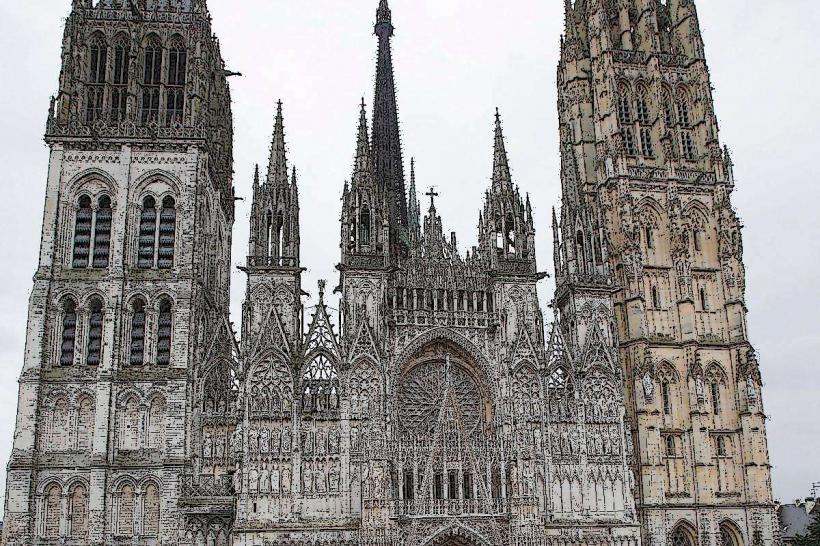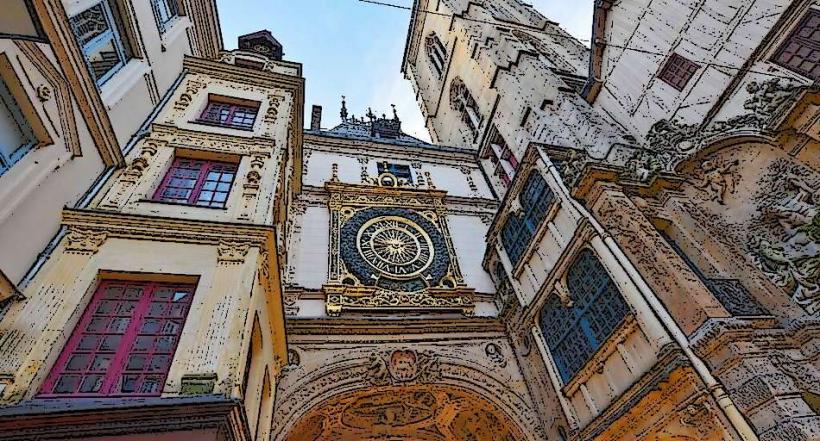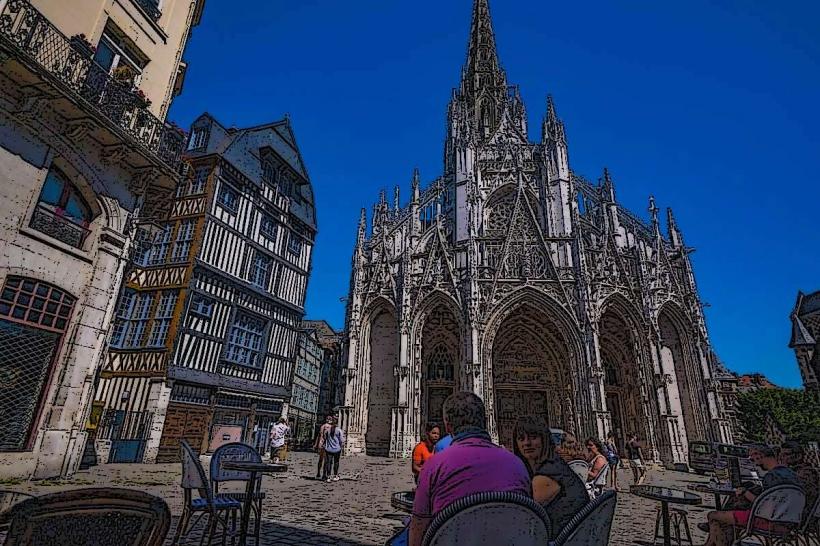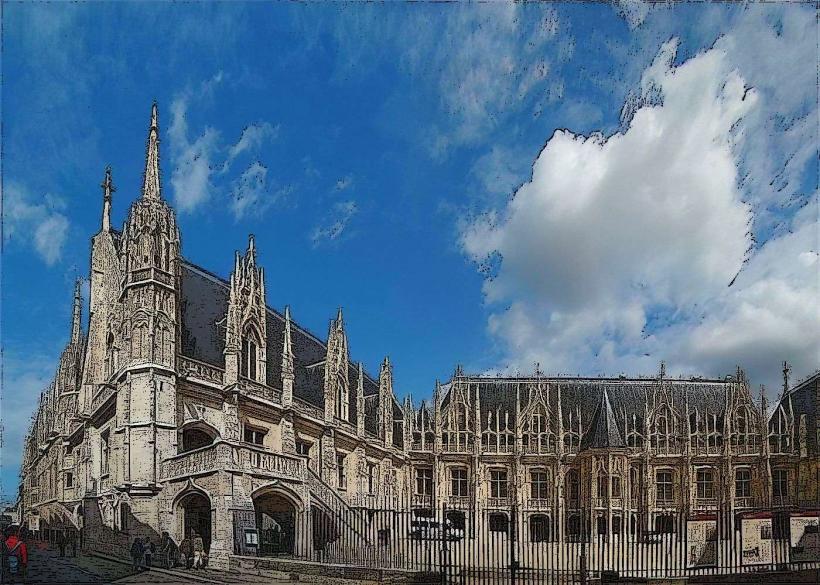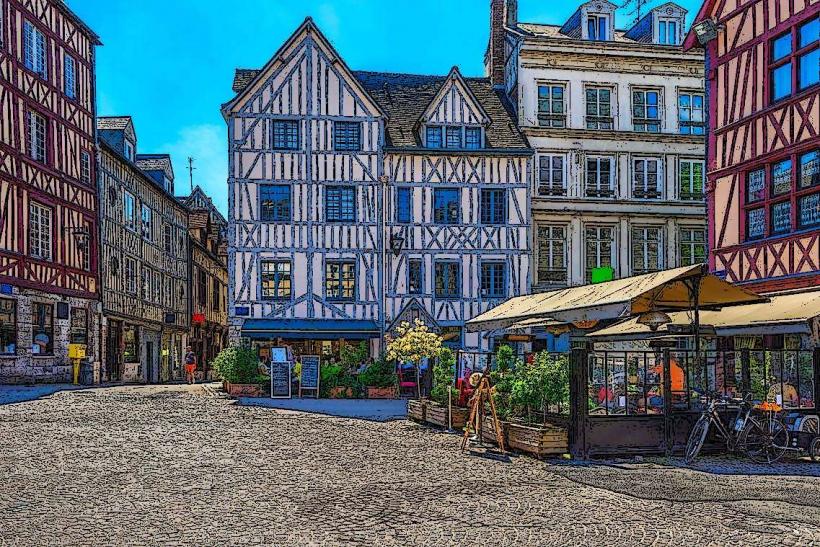Information
City: RouenCountry: France
Continent: Europe
Rouen is a historic city located in northern France, in the region of Normandy, along the banks of the Seine River. It is the capital of the Seine-Maritime department and has played a significant role in French history, particularly during the Middle Ages. Known for its medieval architecture, cathedrals, and artistic heritage, Rouen is often considered one of France's most beautiful cities, offering a rich blend of history, culture, and charm.
1. History of Rouen
Rouen’s history dates back to Roman times when it was known as Rotomagus, a major settlement in the province of Gallia Lugdunensis. Over the centuries, Rouen has been an important center for politics, religion, and commerce. It became the capital of the Norman Duchy in the 10th century and later the capital of Normandy after the conquest of England by the Normans in 1066.
Middle Ages: Rouen became a major city during the Middle Ages, playing an important role in trade and administration. The city is particularly notable for its association with Joan of Arc, who was captured in 1430 and executed by burning at the stake in Rouen in 1431. This tragic event deeply affected the city's history and left a lasting legacy.
French Revolution and Industrialization: Rouen's role shifted in the late 18th century during the French Revolution when it was a focal point of political and social upheaval. By the 19th century, it had developed into a significant industrial hub, particularly for textiles, and became known for its shipbuilding and petroleum industries.
World War II: Rouen suffered significant damage during World War II, especially after it was bombed by the Germans in 1944. However, much of the city’s historical architecture was preserved, and Rouen has since undergone major restoration projects.
2. Key Landmarks and Attractions
Rouen is home to several historic monuments, medieval buildings, and museums that attract visitors from all over the world.
Rouen Cathedral (Cathédrale Notre-Dame de Rouen): The Rouen Cathedral is one of the most famous landmarks in the city and is considered one of the greatest examples of Gothic architecture in France. It is renowned for its tall spire, which, at 151 meters, was once the tallest in the world. The cathedral houses several stained-glass windows, including medieval ones, and an impressive organ. The cathedral is also famous for being the subject of several paintings by Claude Monet, who captured it in various lighting conditions.
Place du Vieux-Marché (Old Market Square): The Place du Vieux-Marché is the historic square where Joan of Arc was executed in 1431. Today, the square is home to the Church of St. Joan of Arc, a modern church built in 1979 to commemorate her death. The church is unusual in its design, with a striking glass façade and contemporary architecture that contrasts with the surrounding medieval buildings. The square is also a lovely spot to sit, enjoy local cafes, and soak in the atmosphere.
Gros-Horloge (Great Clock): The Gros-Horloge is one of the most iconic features of Rouen. It is a 14th-century astronomical clock that spans a street and connects two buildings. The clock is a marvel of medieval engineering and is beautifully decorated with gold accents. The Gros-Horloge was originally part of the city’s defensive walls and still stands as a symbol of Rouen's historical importance.
Palais de Justice (Palace of Justice): The Palais de Justice is another significant historical building in Rouen, once the seat of the Parlement of Normandy. This majestic structure was built in the 16th century in a combination of Gothic and Renaissance styles. The palace has been extensively renovated and today houses the city's courts. Its facade is intricately carved with sculptures depicting biblical and historical scenes.
Museum of Fine Arts (Musée des Beaux-Arts de Rouen): Rouen is home to the Museum of Fine Arts, which houses an impressive collection of European paintings, sculptures, and decorative arts. The museum’s collection includes works by masters such as Goya, Delacroix, and Pissarro, as well as a significant number of paintings by Monet and his contemporaries. The museum is housed in a 19th-century mansion, and visitors can also enjoy its peaceful gardens.
The Joan of Arc History Museum: The Joan of Arc Museum is located near the Place du Vieux-Marché and is dedicated to the life and trial of Joan of Arc. The museum provides an in-depth exploration of her trial, her execution, and her eventual canonization. Exhibits include reproductions of medieval documents, costumes, and paintings depicting Joan’s martyrdom.
Rue du Gros-Horloge: The Rue du Gros-Horloge is one of Rouen’s most picturesque streets, known for its medieval buildings, charming boutiques, and cafes. It is the main thoroughfare connecting the Place du Vieux-Marché with the Place de la Cathédrale. The street is lined with timber-framed houses and historic shops, making it a delightful place for a leisurely stroll.
Abbey of Saint-Ouen: The Abbey of Saint-Ouen is a former Benedictine abbey that now houses a magnificent church. The Gothic church is known for its soaring arches, stained-glass windows, and beautiful cloisters. The abbey is an excellent example of Normandy’s architectural heritage and is a must-see for history and architecture enthusiasts.
Church of Saint-Maclou: The Church of Saint-Maclou is another architectural gem in Rouen, showcasing the Flamboyant Gothic style. The church is famous for its intricate carvings, elaborate stained-glass windows, and sculpted portals, making it one of the most beautiful churches in the city.
3. Festivals and Events
Rouen hosts a variety of cultural events throughout the year, including:
Les Régates de Rouen: This annual sailing festival takes place on the Seine River and features a series of competitive yacht races and nautical events. It attracts participants and spectators from around the world.
Festival de Rouen: A classical music festival that showcases both renowned and emerging artists in the city’s historic venues, including the Rouen Cathedral and the Gros-Horloge.
Rouen Impressionniste Festival: A celebration of the Impressionist art movement, this festival is held every two years and includes exhibitions, performances, and events that explore the work of artists like Claude Monet and Édouard Manet, who were closely associated with Rouen.
4. Cuisine and Local Food
Rouen’s cuisine is heavily influenced by Normandy and its proximity to the sea. Some local specialties include:
- Duck from Rouen (Canard Rouennais): A regional dish made with duck, often prepared with orange sauce and Normandy cider.
- Moules à la crème Normande: Mussels served in a creamy sauce made with cider and cream, a typical dish from the Normandy region.
- Tarte Normande: A delicious dessert made with apples and almond cream.
5. Conclusion
Rouen is a city steeped in history and culture, offering a unique blend of medieval landmarks, Impressionist art, and Normandy cuisine. From the soaring Rouen Cathedral to the Joan of Arc Museum and charming streets filled with timber-framed houses, there is much to explore and discover in this fascinating city. Rouen’s mix of historical significance, architectural beauty, and vibrant atmosphere makes it a must-visit destination in northern France.

